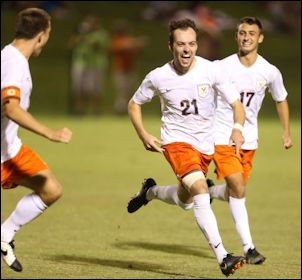
Hey, Wahoo soccer team, congratulations on winning the national championship this year! We’re proud of you. Now, figure out how to make your team financially self-supporting and stop dunning the general student population for your most excellent college experience.
by James A. Bacon
House Majority Leader Kirk Cox, R-Colonial Heights, is intimately acquainted with the high and rising cost of higher education in Virginia. His two oldest have graduated from Longwood University and James Madison University, and he has two high-schoolers on the way. Not surprisingly, he describes himself as “stressed and anxious” about the increasing cost of higher education.
Unlike most of us, Cox is in a position to do something about it. In a Richmond Times-Dispatch op-ed, he said that he plans introduce legislation this year that will place caps on mandatory non-educational student fees at Virginia universities.
Student fees are only one factor driving up the rising cost of higher education, but they are the fastest-growing factor. Mandatory fees unrelated to education now represent one-third of total tuition and fees, or about $3,500 per year on average, Cox says. That’s up 99% since 2003. Writes Cox:
These fees are used to pay for a number of functions, but a significant portion is used to fund intercollegiate athletics. Only 3 percent of Virginia students play intercollegiate sports, but student fees fund approximately 69 percent of expenditures in athletic programs at Virginia’s four-year schools. In other words, non-athletes and their parents are paying about two-thirds of the cost of intercollegiate athletics. …
Athletic programs are an important part of the college experience. Virginia is fortunate to have competitive college athletic programs that make students and alumni proud. But we simply cannot ask students who will never play a minute of college sports to bear such a disproportionate share of the costs associated with these programs.
I totally agree, but I’d go farther. Male football and basketball programs pay their own way. No other sports program does. If students want to participate in volleyball, soccer, tennis and the like as part of their college experience, let them pay for it themselves. I studied Korean martial arts at the University of Virginia many moons ago. Everybody kicked in to pay an instructor to drive down from Northern Virginia to teach us. We didn’t think anything about it. Obviously, traveling sports teams with full-time coaches would cost a lot more. Perhaps they should emulate the non-profit soccer and Little League programs here in Henrico County (and many other places) that raise money from parents, bequests, fund-raisers ticket sales and the like.
Once upon a time, it may have been appropriate for colleges and universities to pass on the cost of college athletics to the general student population. But Boards of Trustees simply have to re-think priorities when the cost of education becomes unaffordable to most. Why should one student be compelled to rack up additional student debt to subsidize the amateur athletic experience of another? And not to go all Al Sharpton on the issue, but let’s consider the social justice ramifications. How many poor and minority students participate in lacrosse, golf, rowing, swimming & diving and field hockey? Is it fair to ask poor and minority students to subsidize the college experience of preppy white students?
Runaway student fees deserve a much closer look. Personally, I’d give public universities ten years to put their athletic programs on a self-funding basis and phase out subsidies from student fees entirely. But Kirk Cox’s proposal, though modest, is a good start.


